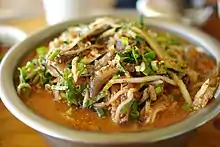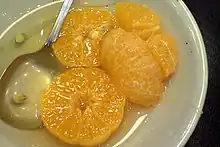List of Jeju dishes
Because of its geographic location off the Korean peninsula, the province of Jeju has cuisine mainly centered around seafood. Along with fish, shellfish, and squid, Jeju is known for its oranges. The antioxidant levels within the Jeju oranges hold significantly higher quantities than any other oranges produced and grown within the country because of the soil content on the island. Not only is the popularity just focused on oranges, but many other varieties of citrus fruits such as lemons or limes and mixed breeds of citrus fruits such as clementines. Because of this, much of the island's alcoholic beverages that are produced locally are all typically tied into the citrus production. Many local markets and stores emphasize on the sales of citrus products and it is one of the major exports out of Jeju island. The inhabitants of Jeju also have a higher focus on “healthy foods” or foods that hold higher standards of nutrients considered important for proper health benefits on the human body. It is believed that biologically, the inhabitants of Jeju crave or biologically search out nutrient dense foods because of generations being raised on the readily available foods. The inhabitants of Jeju readily included a form of roe into their diets that were so dense in omega oils that their bodies were able to differentiate the differences in the seasonal changes in the fishes breeding styles. Because of the higher focus on quality and purity of its food sources, its awarded quality of citrus fruits, and its traditional values held surrounding cuisine, Jeju is considered a food tourist attraction for both native Koreans and International travelers alike. This is a list of typical Jeju dishes found in Korean cuisine.
Main dishes
- Japgokbap, (잡곡밥), made with multiple grains
- Saengseon guksu, (생선국수), noodles made with fish
- Memil kalguksu, (메밀칼국수), noodle dish made with buckwheat[1]
- Memil jeobaegi, (메밀저배기), made with buckwheat
- Memil mandu, (메밀만두), mandu (dumpling) made with a buckwheat covering
- Gontteok guk, (곤떡국), made with tteok (rice cakes)
Porridge

- Memil beombeok, (메밀범벅), thick porridge made with buckwheat and other grains
- Haemuljuk, (해물죽), porridge made with seafood
- Jeonbokjuk, (전복죽), porridge made with abalone
- Okdomjuk, (옥돔), porridge made with tilefish
- Gingijuk, (깅이(게)), porridge made with crabs
- Chogijuk, (초기죽), porridge made with shiitake
- Dakjuk, (닭죽), porridge made with chicken
- Maeyeoksaejuk, (매역새죽), porridge made with young wakame
- Bomaljuk, (보말죽), porridge made with buckwheat Omphalius rusticus[2]
Challyu
- Gosari guk, (고사릿국), made with fernbrake
- Tot naengguk, (톳냉국)
- Pork yukgaejang, (돼지고기육개장), spicy soup made with pork
- Doenjang jjigae, (된장찌개), jjigae made with fermented soybean paste
- Bokjaengi jijimi, (복쟁이지짐이)
- Sangeo jijimi, (상어지짐이)
- Obunjaengi jjim, (오분쟁이찜)
- Jari jijimi, (자리지짐이)
- Dwaejigogi jorim, (돼지고기조림)
Grilled dishes

- Okdom gui, (옥돔구이), grilled Tilefish
- Dwaejigogi gui, (돼지고기구이), made with pork
- Bollak gui, (볼락구이)
- Sangeopo gui, (상어포구이), made with dried shark fillet
Pancakes
- Sangeo sanjeok, (상어산적), made with shark
- Gyeoran jeon, (계란전), made with eggs
- Gosari jeon, (고사리전)
- Chogi jeon, or called pyogo jeon (초기전, 표고전), made with shiitake
- Kkwong jeok, (꿩적), made with pheasant meat
- Memilmuk jijimi , (메밀묵지짐이)
- Kkwong jijimi, (꿩지짐이), made with pheasant meat
Pickles
- Huchutip jangajji, (후춧잎장아찌), pickle made with pepper leaves
- Putgochu oijangajji, (풋고추오이장아찌), pickle made with green chili pepper and cucumber in soy sauce
Raw dishes

- Jarihoe, (자리회)), made with damselfish
- Jari mulhoe, (자리물회), made with damselfish
- Jari ganghoe, (자리강회)
- Jeonbok sorahoe, (전복소라회)
- Molmang hoe, (몰망회)
- Ojingeo hoe, (오징어회), sliced raw squid made with squid
- Bigye hoe, (비계회)
- Dwaeji saekkihoe, (돼지새끼회)
Sauteed vegetables
- Yangae muchim, (양에무침)
- Totnamul, (톳나물)
Wraps
- Nalmiyeok ssam, (날미역쌈)
- Naldasima ssam, (날다시마쌈)
- Kongnip ssam, (콩잎쌈)
Kimchi
- Jeonbok kimchi, (전복김치)
- Dongji kimchi, (동지김치)
- Haemul kimchi, (해물김치)
- Nabak kimchi, (나박김치)
Tteok

- Bingtteok, (빙떡), tteok made with buckwheat
- Banchalgon tteok, (반찰곤떡)
- Dal tteok, (달떡, literally "moon tteok"), tteok made by pounding rice and shaped into a circle like a full moon. It is also a local specialty of Hamgyong province.[3][4]
- Dodom tteok, (도돔떡), made with rice
- Chim tteok or called jopssal sirutteok, (침떡, 좁쌀시루떡)
- Chajopssal tteok, (차좁쌀떡), made with Italian millet
- Omaegi tteok, (오매기떡), tteok made with Italian millet and shaped into a ring[5]
- Dollae tteok, (돌래떡), made with Italian millet flour or buckwheat flour.[6]
- Sok tteok, (속떡, 쑥떡), tteok made by pounding rice and boiled ssuk (Artemisia indica).[7][4]
- Memil bukkumi, (메밀부꾸미), made by pan-frying pieces of dough made with buckwheat and stuffed with a sweeten filling.[8]
- Ppadaegi tteok or called gamje tteok, (빼대기, 감제떡), tteok made with powder of dried sweet potato and shaped like songpyeon[9]
- Sangae tteok, (상애떡), tteok made with wheat flour and makgeolli (rice wine)[10]
Desserts
- Yakgwa, (약과), a variety of yumil-gwa in hangwa, Korean traditional confectionery, made with honey and wheat flour[11]
- Dak yeot, (닭엿), yeot (candy) made with glutinous millet and chicken[12]
- Kkwog yeot, (꿩엿), yeot made with glutinous millet and pheasant meat[13]
- Dwaejigogi yeot, (돼지고기엿), yeot made with glutinous millet and pork[14][15]
- Haneulaegi yeot, (하늘애기엿), yeot made with glutinous millet and Trichosanthes kirilowii[16][17]
- Hobak yeot, (호박엿), yeot made with pumpkin
- Bori yeot, (보리엿), yeot made with barley
- Maneul yeot, (마늘엿), yeot made with glutinous millet and garlic[18]
Non-alcoholic beverages

- Sulgamju, (술감주), made with chilled steamed rice and nuruk (a fermentation starter)[19]
- Milgam hwachae, (밀감화채), hwachae (punch) made with Mandarin orange[20]
- Jagulcha, (자굴차), made with dried leaves of Albizia julibrissin[21][22]
- Soyeopcha, (소엽차), made with dried Limnophila aromatica[23][24]
References
- "Buckwheat". Archived from the original on 2018-05-11. Retrieved 2018-05-19.
- "Buckwheat products". Archived from the original on 2018-05-11. Retrieved 2018-05-19.
- 달떡 (in Korean) Doosan Encyclopedia
- 향토음식 鄕土飮食 Archived 2011-06-10 at the Wayback Machine (in Korean) Nate / Encyclopedia of Korean Culture
- 오메기떡 (in Korean) Doosan Encyclopedia
- 돌래떡 Archived 2011-07-22 at the Wayback Machine (in Korean) National Academy of Agricultural Science
- 쑥떡 (in Korean) Doosan Encyclopedia
- 부꾸미 Archived 2009-02-06 at the Wayback Machine (in Korean) Doosan Encyclopedia
- 빼대기떡 (in Korean) Doosan Encyclopedia
- 상외떡 (in Korean) Doosan Encyclopedia
- 약과 yakgwa / Deep-fried Honey Cookies 藥果 (in Korean) Doosan Encyclopedia
- 닭엿 (in Korean) Doosan Encyclopedia
- 꿩엿 (in Korean) Doosan Encyclopedia
- Gu, Seon-suk (구선숙), (March 2009) 돼지고기엿과 보말죽 Archived 2011-07-22 at the Wayback Machine (in Korean) Haengboki gadeukhan jip (행복이 가득한 집)
- 돼지고기엿 Archived 2011-07-22 at the Wayback Machine (in Korean) National Academy of Agricultural Science
- 엿 Archived 2011-06-10 at the Wayback Machine (in Korean) Nate / Britannica
- 하늘타리 Trichosanthes kirilowii (in Korean) Doosan Encyclopedia
- 마늘엿 (in Korean) Doosan Encyclopedia
- 술감주 (in Korean) Doosan Encyclopedia
- 밀감화채 (in Korean) Doosan Encyclopedia
- 자굴차 (in Korean) Doosan Encyclopedia
- 자귀나무 Jagwi namu (in Korean) The Arboretum of Halla
- 소엽차 (in Korean) Doosan Encyclopedia
- 소엽풀 蘇葉 ─ Limnophila aromatica (in Korean) Doosan Encyclopedia
External links
- Official site of Korea National Tourism List of Korean Food Archived 2013-09-28 at the Wayback Machine
- Food in Korea at the Korea Agro-Fisheries Trade Corporation
- 한국의 떡 (in Korean) uriculture.com